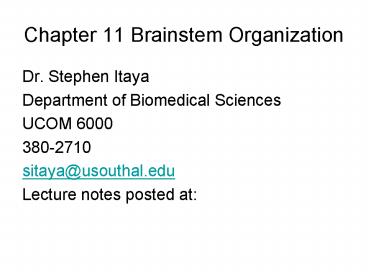Chapter 11 Brainstem Organization - PowerPoint PPT Presentation
1 / 32
Title:
Chapter 11 Brainstem Organization
Description:
motor. Brainstem. X-sections. Asc-Desc Tracts. Spinothalamic ... Fxn: desc pain control, PAG-raphe-dorsal horn. Fxn: decr 5HT - depression. Review blood supply ... – PowerPoint PPT presentation
Number of Views:57
Avg rating:3.0/5.0
Title: Chapter 11 Brainstem Organization
1
Chapter 11 Brainstem Organization
- Dr. Stephen Itaya
- Department of Biomedical Sciences
- UCOM 6000
- 380-2710
- sitaya_at_usouthal.edu
- Lecture notes posted at
2
Lateral Medullary Syndrome
- (Chapter 12 preview)
- Loss of pain and temperature - left body
- Sparing of touch
- Loss of pain and temperature - right face
- Hoarseness and difficulty swallowing
- Right Horners syndrome (loss of sympathetic
innervation to face) - Vertigo
- Nystagmus (abnormal eye movements)
- Cerebellar ataxia
PICA
3
Structural Overviewof Brainstem
- Midbrain, pons, medulla
- Fourth ventricle
- Foramen magnum
4
Brainstem Structural Components
- Tracts
- Ascending
- ALS, DCML
- Descending
- Corticospinal, corticopontine, corticobulbar
- Relay
- Cerebellar peduncles
- Internal structures reticular formation, relay
nuclei - CN III-XII (later lectures)
5
Gross Anatomy Review
- Dorsal medulla
6
Medulla - dorsal
Rhomboid fossa Posterior median sulcus Sulcus
limitans Median eminence Stria medullaris of 4th
ventr. Facial colliculus Vestibular area Foramen
of Luschka Hypoglossal trigone Vagal
trigone Obex Gracile tubercle
fasciculus Cuneate tubercle fasc. Post.
Intermediate sulcus
7
Medulla - ventral
Anterior median fissure Pyramids Pyramidal
decussation Preolivary sulcus (CN
IX-XI) Olive Postolivary sulcus (CN
XII) Tuberculum cinereum
8
Pons - dorsal
Rhomboid fossa Cerebellar peduncles (inf, mid,
sup) Superior medullary velum VSCT
9
Pons - ventral
- Basilar pons
- Basilar artery
- CN V-VIII
- Middle cerebellar peduncle
10
Midbrain - dorsal
- Superior colliculi
- Inferior colliculi
- Brachium of IC
- CN IV
- (pineal, pulvinar, MGN, LGN)
11
Midbrain - ventral
- Cerebral peduncles
- Interpeduncular fossa
- CN III
- Posterior perforated substance
- (between mammillary bodies pons)
12
Brainstem - medial
- 4th ventricle
- Cerebellum
- Superior medullary velum
- Superior cerebellar peduncle
- Inferior medullary velum
- Cerebral aqueduct
- Tectum
- Basilar pons
- Medulla
13
Brainstem Motor-Sensory Org.
Alar plate -sensory Basal plate -motor
14
Brainstem X-sections
Asc-Desc Tracts Spinothalamic tract Corticospinal
tract DCML Reticular formation
15
Brainstem X-sections
- Caudal medulla
- Rostral medulla
- Caudal pons
- Rostral pons
- Caudal midbrain
- Rostral midbrain
- Skipping most CN
16
Caudal medulla pyramidal decussation
- DCML
- Gracile cuneate nuc. and fasc.
- Sp. Tr. Nuc. Of V
- DSCT, VSCT
- ALS
- Ant. Horn (XI)
- Pyramids
- Corticospinal tr.
17
Sp. Tr. Nucl. Of V
- Fig 15-1
18
Caudal medullaint arcuate fibers
- DCML gracile cuneate nuc fasc
- Int arcuate fibers ML
- MLF
- Lat / Access cuneate nuc
- Sp. Tr. Nuc. Of V
- DSCT, VSCT
- ALS
- Inferior olivary nuc
- Pyramids
19
Rostral medullainf olivary nuc
- 4th ventricle
- Lat / access cuneate nuc
- Inf cerebel ped
- XII nuc
- Sp tr nuc V
- MLF
- ML
- ALS
- VSCT
- Inf olivary nuc olivocerebell fibers
- Pyramids
- CN XII
20
Caudal ponsfacial colliculus
- 4th ventr.
- Deep cerebel nuc
- Sup/mid/inf cerebel ped
- MLF
- VI nucl
- VII fibers
- Sp tr and nuc V
- CTT
- ML - ALS
- Pontine nuc
- Corticosp tr
21
MidponsCN V
- Sup / mid cerebel ped
- VSCT
- 4th ventricle
- MLF
- CTT
- CN V main sens nuc
- ML ALS
- Pontine nuc
- Corticosp tr
22
Rostral pons
- 4th ventricle
- Sup cerebel ped
- MLF
- CTT
- ML-ALS
- Pontine nuc
- Corticosp fibers
23
Caudal midbrainSCP decussation
- Inf colliculus
- Cerebral aqueduct
- PAG
- MLF
- ML-ALS
- Cerebral peduncle
- Interped fossa
- CN III
24
Rostral midbrainSup Colliculi
- Cerebral aqueduct
- PAG
- CN III nuc
- MLF
- ML-ALS
- Inf brachium
- Red nucleus
- SN
- Cerebral peducle
25
Reticular formation(Latin incomprehensible ? )
- Part of primitive brain
- Diffuse network
- Polyneuronal, polysynaptic, polymodal, asc
desc, crossed and uncrossed, axon collaterals - Location tegmentum of medulla, pons, midbrain
26
Reticular formation
- Inputs diffuse, all forms of sensation, from sp
cord CN, cerebral ctx, hypothal, limbic sys,
basal gangl - Outputs diffuse, cerebral ctx, sp cord
- ANS centers
- Respiratory centers
- Cardiovascular centers
27
Horners syndrome
- Through brainstem near ALS
- Desc symp path from hypothal to intermediolateral
cell column - Ipsilateral face
- Miosis constric pupil
- Ptosis droopy eyelid
- Anhydrosis no sweating
28
Chemical Organization of the Reticular Formation
- Locus ceruleus NE
- SN/VTA - DA
- Raphe nuclei 5HT
29
Locus ceruleus
- NE neuronal soma
- Location floor of rostral 4th ventricle
- Asc and desc fibers throughout CNS
- Active when awake
- Most active when startled
- Ascending reticular activating system
- Damage - coma
30
Substantia nigra VTA
- DA neuronal soma
- Location midbrain
- Output caudate putamen, forebrain
- Fxn movement control (PD), motivation (nuc
accumbens)
31
Raphe nuc
- 5HT neuronal soma
- Location midline brainstem
- Output all areas of CNS
- Fxn overall level of arousal, sleep-wake cycle?
- Fxn desc pain control, PAG-raphe-dorsal horn
- Fxn decr 5HT - depression
32
Review blood supply
- Vertebral
- Basilar
- Posterior cerebral
- Anterior spinal
- Posterior spinal
- PICA
- AICA
- Superior cerebellar
- Posterior communicating
- See figure 11-26

